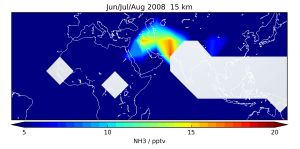Population is growing, climate is warming – hence, emission of ammonia (NH3) trace gas from e.g. agriculture will increase worldwide. Recently, scientists of Karlsruhe Institute of Technology (KIT) for the first time detected NH3 in the upper troposphere. Together with researchers from Colorado/USA and Mexico, they analyzed satellite measurements by the MIPAS infrared spectrometer and found increased amounts of NH3 between 12 and 15 km height in the area of the Asian monsoon. This suggests that the gas is responsible for the formation of aerosols, smallest particles that might contribute to cloud formation. The researchers present their work in the Atmospheric Chemistry and Physics journal. (DOI: 10.5194/acp-16-14357-2016)
Ammonia, a chemical compound of nitrogen and hydrogen, mainly originates from agricultural processes, in particular from lifestock farming and fertilization. Wide application of ammonia as a basic substance of fertilizers became possible by the development of artificial ammonia synthesis in Karlsruhe more than 100 years ago. Today, highest ammonia emissions are encountered in North India and Southeast China. Due to population growth and global warming, global ammonia emissions are expected to increase strongly in the future. Gaseous ammonia reacts with acids, such as sulfuric acid or nitric acid, to the corresponding ammonium salts. However, ammonia does not only pollute the ecosystems. Particles of ammonium salts can attach to each other and form aerosol particles acting as condensation nuclei in cloud formation. Such aerosols of anthropogenic origin have a cooling effect in the atmosphere and might compensate part of the anthropogenic greenhouse effect.
In this connection, it is important to determine vertical distribution of atmospheric ammonia. Concentrations of ammonia in the middle and upper troposphere, the bottom layer of the atmosphere, have hardly been studied so far. Now, researchers of the Atmospheric Trace Gases and Remote Sensing Division of KIT’s Institute for Meteorology and Climate Research (IMK-ASF) as well as of the University of Colorado at Boulder and the Universidad Nacional Autónoma de México for the first time detected ammonia in the upper troposphere. They evaluated measurements made by the MIPAS infrared spectrometer on the European environmental satellite ENVISAT from 2002 to 2012. MIPAS, an instrument designed by KIT, recorded highly resolved spectra in the middle infrared range, from which gases can be identified clearly. Every gas emits specific infrared radiation.
The scientists calculated the average of three-month measurements in areas of ten degrees longitude and ten degrees latitude each. At 12 to 15 km height, in the area of the Asian monsoon, they found an increased concentration of ammonia of up to 33 pptv (33 NH3 molecules per trillion air molecules). Similarly high concentrations were measured in no other season and no other region. “Observations show that ammonia is not washed out completely when air ascends in monsoon circulation. Hence, it enters the upper troposphere from the boundary layer close to the ground, where the gas occurs at relatively high concentrations,” Dr. Michael Höpfner, Head of the Remote Sensing Using Aircraft and Balloons Group of IMK-ASF. “It is therefore assumed that part of the Asian tropopause aerosol layer consists of ammonium salts.”
Outside of the area of the Asian monsoon, concentrations of ammonia in the upper troposphere were found to be below the detection limit of a few pptv. This finding can contribute to refining global models. As far as the Asian monsoon is concerned, a large measurement campaign with the GLORIA instrument is planned in 2017. GLORIA is a novel type of infrared camera that decomposes the thermal radiation emitted by atmospheric gases into its spectral colors and, hence, yields ammonia concentration results near the tropopause, the boundary layer between the troposphere and the above stratosphere, of higher temporal and spatial - horizontal and vertical - resolution.
Michael Höpfner, Rainer Volkamer, Udo Grabowski, Michel Grutter, Johannes Orphal, Gabriele Stiller, Thomas von Clarmann, and Gerald Wetzel: First detection of ammonia (NH3) in the Asian summer monsoon upper troposphere. Atmospheric Chemistry and Physics, 2016. DOI: 10.5194/acp-16-14357-2016
More about the KIT Climate and Environment Center: http://www.klima-umwelt.kit.edu/english.
Being “The University in the Helmholtz Association”, KIT creates and imparts knowledge for the society and the environment. It is the objective to make significant contributions to the global challenges in the fields of energy, mobility, and information. For this, about 10,000 employees cooperate in a broad range of disciplines in natural sciences, engineering sciences, economics, and the humanities and social sciences. KIT prepares its 22,800 students for responsible tasks in society, industry, and science by offering research-based study programs. Innovation efforts at KIT build a bridge between important scientific findings and their application for the benefit of society, economic prosperity, and the preservation of our natural basis of life. KIT is one of the German universities of excellence.

